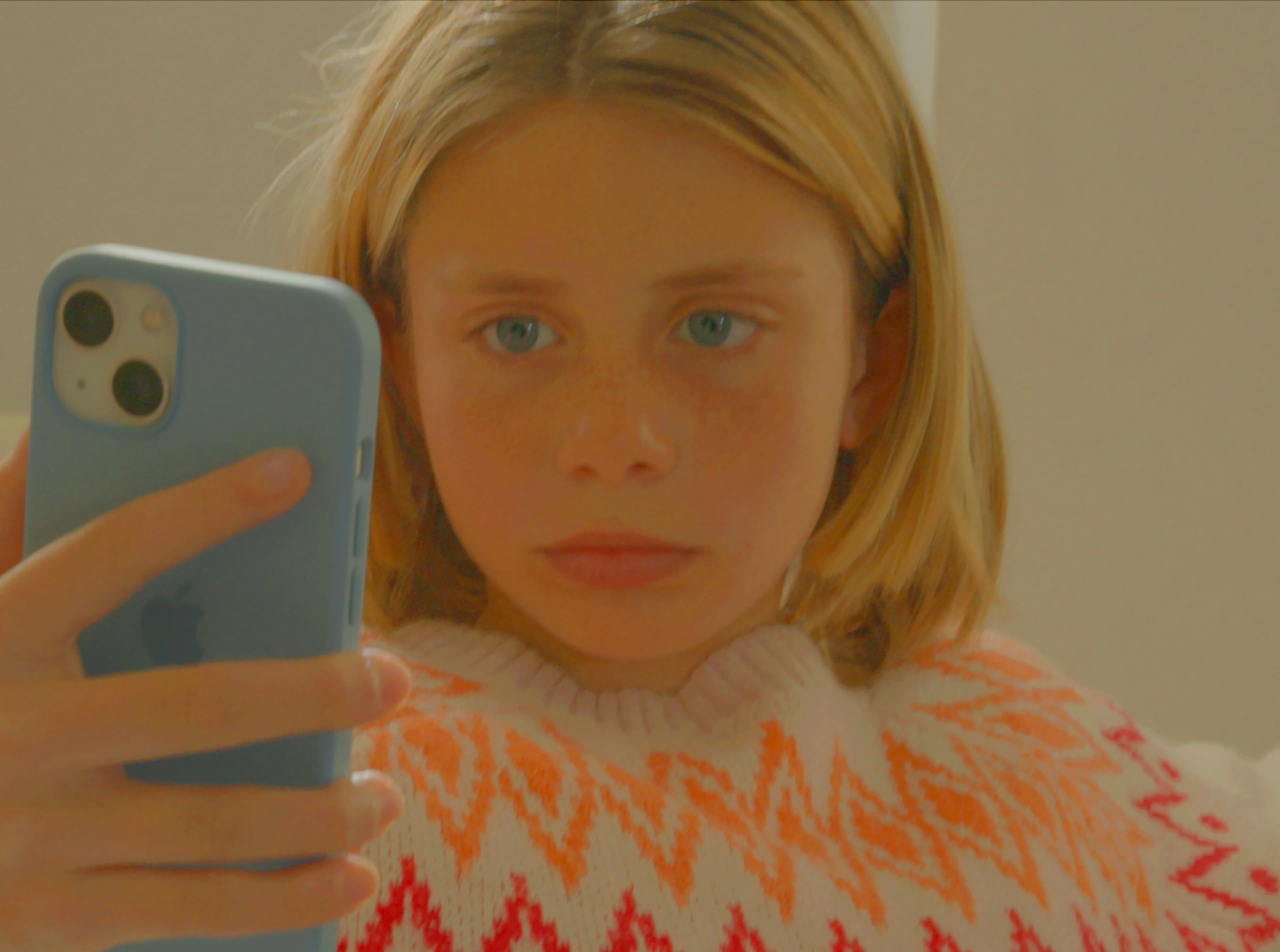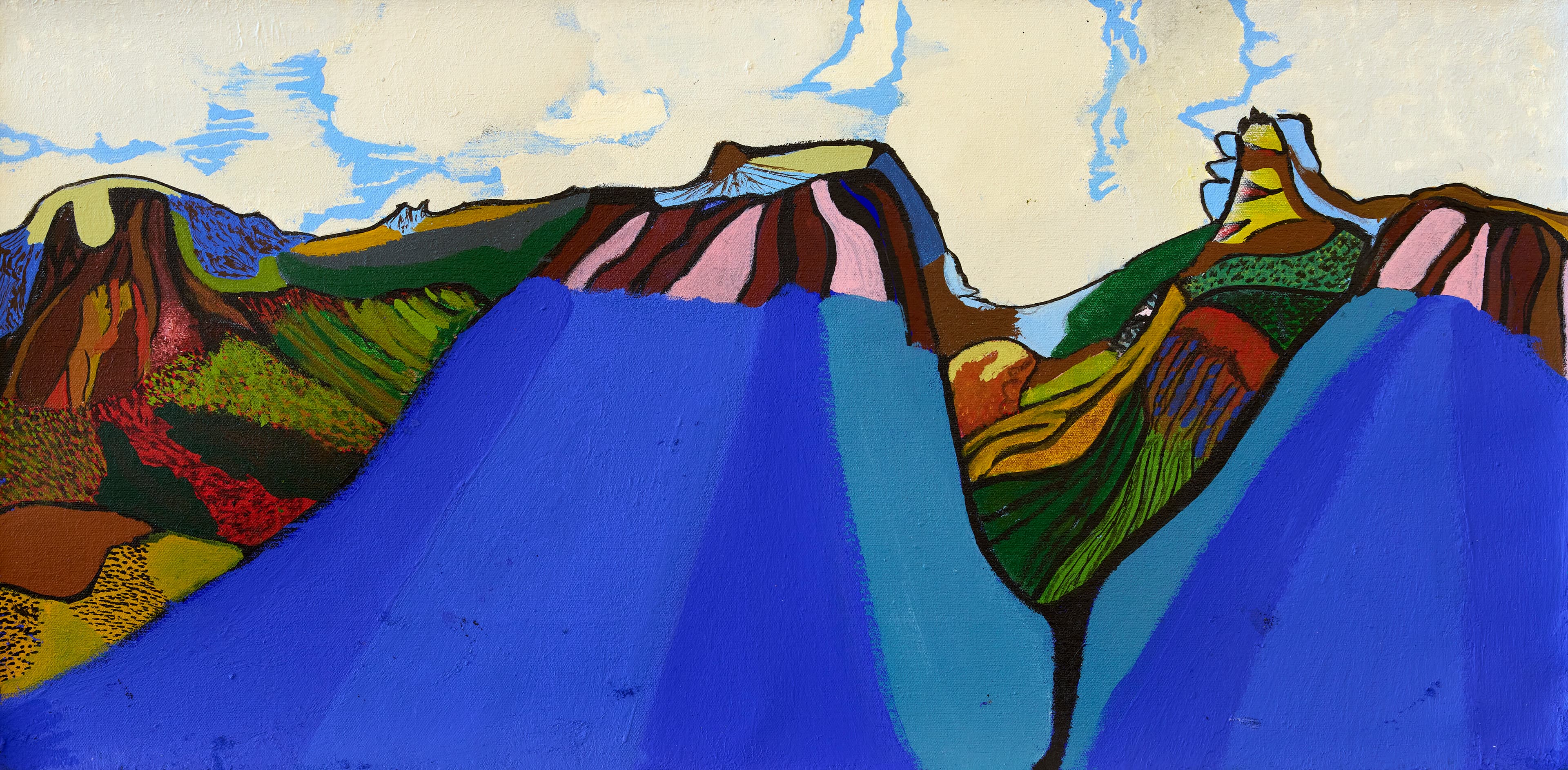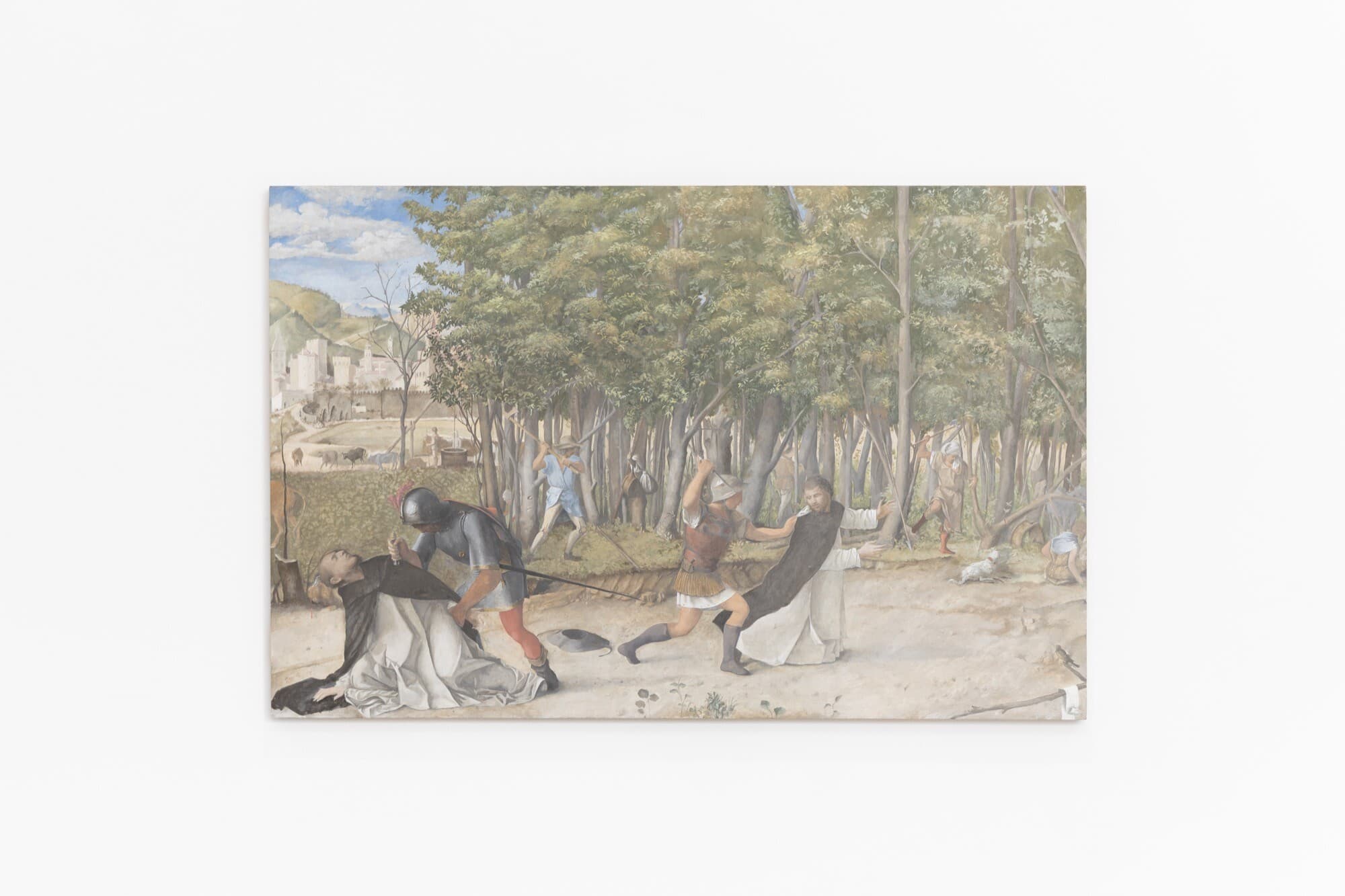Carpet Diem
Talia Smith
I moved to Sydney in 2014, and since then have lived in and around the Inner West, predominantly Petersham and Summer Hill. There is never a week that goes by that I do not need to traverse Parramatta Road, past the faded signage of stores that no longer exist or the many tulle-filled window displays of bridal dress shops, all while breathing in the smell of hot tar and rubber. A previous Mayor deemed the road a “varicose vein” and a “scar on Sydney”. Yet despite the call for the road to be “revitalised”, it remains an expensive nightmare for the Councils it passes through. Most plans of action don’t amount to much, and so the scar remains.
Sydney is not known for maintaining local or lesser-known histories in favour of profit. The $150 million sale of the former housing commission building “Sirius” in The Rocks to private developers in 2019 is but one example of Sydney’s rapacious appetite for renewal. New apartment blocks seem to be going up around every corner, but with the appalling rental market in Sydney, no-one can afford to even live in them. It is an absurd set of circumstances, and as the heady rush for the new drives people out of their neighbourhoods, so too does it erase the histories and stories that they made there. Perhaps that is why I have such a soft spot for Parramatta Road. Despite what is happening around it in the wider city, the road seems forever suspended between the moment of closing-down and the moment of re-development—trapped in a kind of gentrification limbo. It is this state of limbo that allows the road to act as a point for reflection on the city’s consuming drive for renewal.
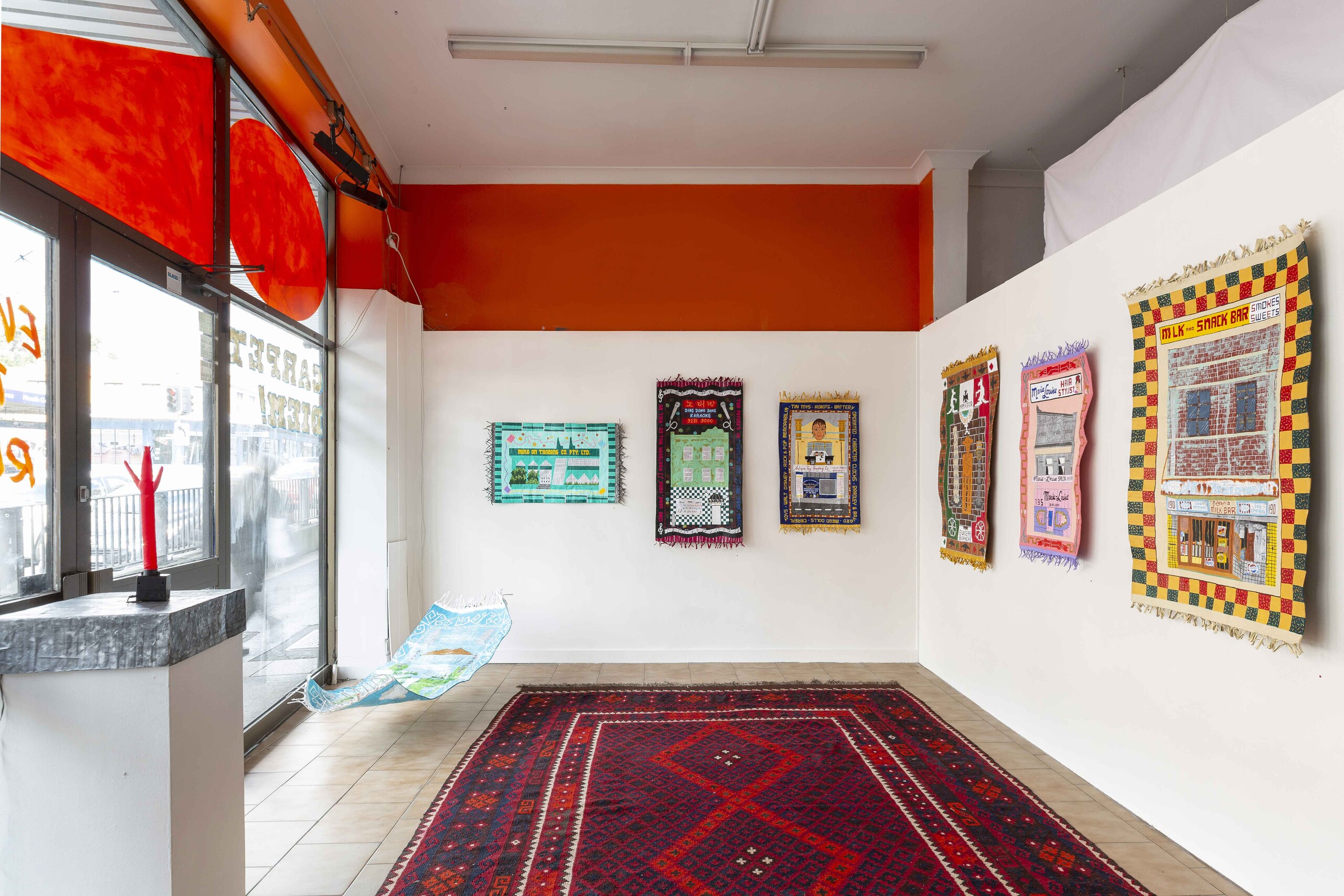
The artist-run gallery and studios Our Neon Foe runs out of an old shopfront on Parramatta Road. Its nondescript façade and limited hours allow it to blend in seamlessly with the rest of the road’s air of abandonment. They do not attempt to gentrify the road but rather work with its perpetual state of closing down to present a range of exhibitions that are viewable 24/7 through the front windows. The space and particularly its current exhibition, Raquel Caballero’s Carpet Diem, embrace the strange energy of the area and use the gallery space as a chance to reflect on this and the gentrification process itself.
Caballero’s practice explores aesthetics of excess or maximalism in popular and folk culture through traditional crafts such as papier-mâché, textiles and quilting. In her role as librarian at the Australian Film Television and Radio School she creates elaborate displays which she has become known and loved for. One of my personal favourites was a display that paid homage to the ultrafragola mirror, to Niki de Saint Phalle’s tarot garden and to some of her favourite movie mirror scenes—think Patrick Bateman peeling his face mask off while staring dead-eyed into his reflection, or the final fight scene in Enter the Dragon where Bruce Lee walks into a hall of mirrors. Caballero has a love for creating works that evoke particular moments of life, cinema and popular culture that have influenced her, and she brings to these scenes an astounding attention to detail.
The installation in Carpet Diem, and its punning title, pays tribute to the phenomena of the always-closing rug store. In fact, I remember just such a rug store that was further down Parramatta Road, closer to the McDonald’s. This store was “closing down” for at least a year and a half, and the number of rugs that could be seen from the outside never seemed to change despite the signage indicating that there were massive bargains to be had inside.

Caballero’s Carpet Diem is an installation of eight meticulously hand-painted papier-mâché sculptures that are made to look like rugs. They feature iconic buildings from Sydney that have either been demolished to make way for apartments or that are sitting empty, falling into disrepair. In her artist’s statement for the exhibition Caballero mentions Sydney’s addiction to gentrification, and it is fitting that her tributes to lost architectural icons takes place on a road that seemingly does not want to change despite it all. If Parramatta Road is in a gentrification limbo then Caballero’s exhibition is the visual representation of that—an art of perpetual closing.
At issue is not just the physical loss of iconic architectures, but also Australia’s embrace of the current global obsession with clean and slick interior design—”Scandi”, “Marie Kondo”, “clean lines”, “white walls” and “concrete” are some of the keywords from the many home interior design shows that I (shamefully) watch. It seems that in 2023 maximalism, or at least ornate decoration, has become something to be eradicated. Caballero’s practice moves vehemently against this, her work instead championing outmoded icons from popular culture that ooze messiness, absurdity and fun.
Upon entry to the exhibition there is a small red inflatable man with his arms flapping around; sitting upon a papier-mâché sculpture of a black tar road, his role is to draw passersby inside. Once there, they will notice a Persian-style rug spread across terracotta-coloured tiles—an aspect of Our Neon Foe’s 1980s décor that matches Cabellero’s aesthetic perfectly. It is hard not to smile when viewing the show; it is bright and colourful, the works have movement despite the stiffness of the material, and it is impossible not to marvel over the careful detail in each work.
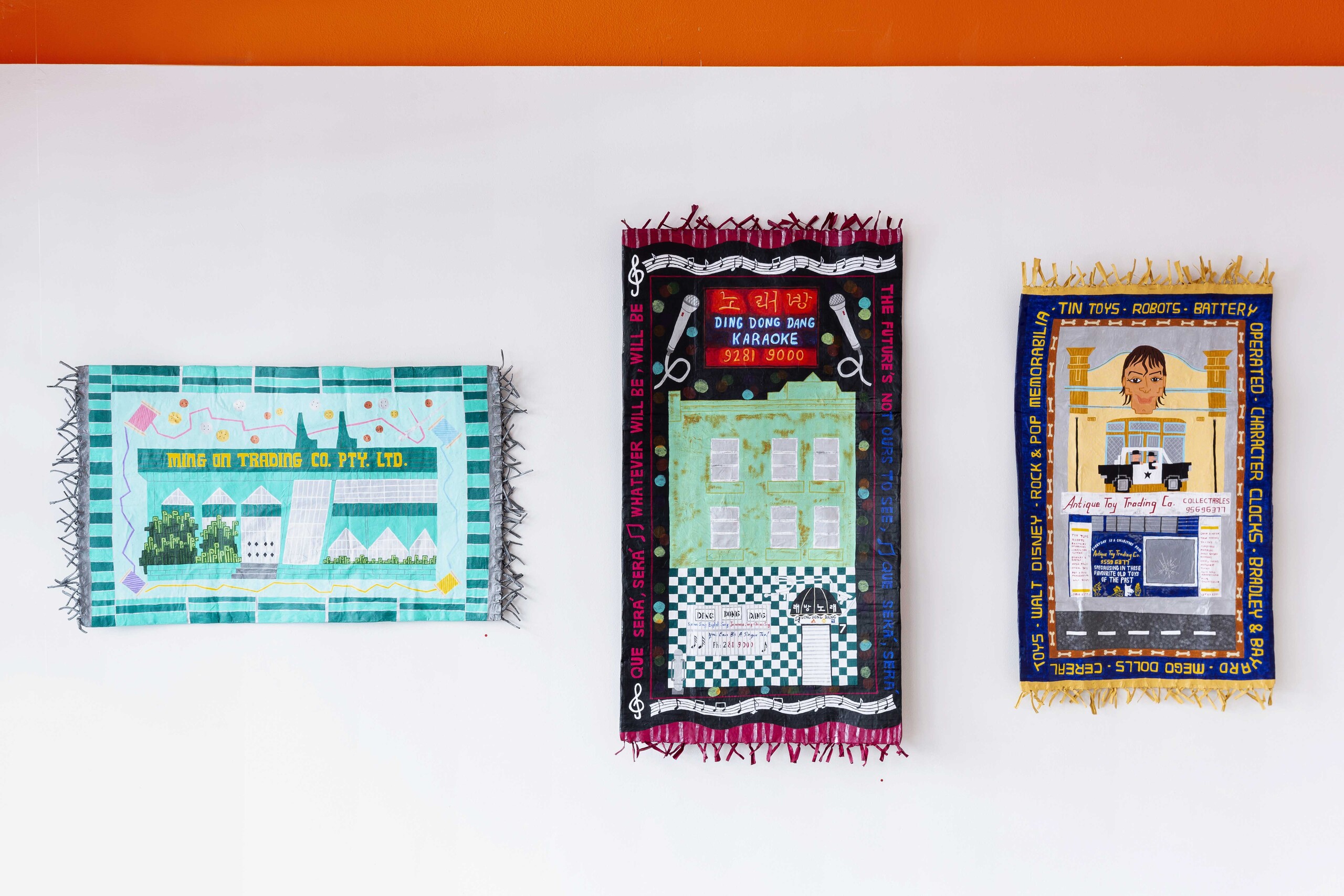
The first work to catch my eye was the rug dedicated to Gould’s Book Arcade. I lived on Alice Street in Newtown when I first moved here. I would walk up King Street to go to Gould’s original location when I didn’t have a job and all the time in the world. I would trawl through the books in their massive warehouse for hours, leaving with a musty book smell on my fingers that I couldn’t quite get rid of. Caballero has not only faithfully painted the now empty building but has even added a border of white price sticker tags with original prices slashed out and the discounted total beneath. The book covers in the window include titles such as Jane Fonda’s Workout Book, the classic The Joy of Sex and a How to Grow Marijuana guide. Caballero has a dry sense of humour and these little details are like a cheeky wink or elbow nudge to the ribs: even if you don’t know her personally she still makes sure you are able to get in on the joke.

Some other iconic buildings that feature on the rugs are the Olympia Milk Bar, Ming On, Ding Dong Dang and the Marie Louise Salon. What unites all these places is that they no longer exist as they once did. The Marie Louise Salon has kept its façade somewhat, but is now a trendy Spanish wine bar, while the Ming On building on Addison Road has succumbed to development only recently, and its teal bricked exterior has now been demolished. Another work pays tribute to the late Giuseppe Bianchi, a well-loved Smithfield resident and Italian immigrant who hand crafted an ode to Italy out of papier-mâché, wood and clay in a museum that he built himself, the Abruzzo Museum. It makes sense for there to be a rug in his honour, given his dedication to celebrating the places that he loved. Artist David Capra (one of Caballero’s close friends) curated a retrospective of Bianchi’s work at Fairfield Museum and Gallery in 2014, and with his recent passing his artworks have found new lives with admirers such as Caballero.

There is a ninth work in the show, and this one is strictly not for sale: it is called Baby Blue and hangs in the front window of the gallery. While the other rugs are pinned to the gallery walls, Caballero has managed to give this work a different life by having it float in the space, hung from different anchor points on the ceiling. Its size is also different from the others indicating that perhaps this rug has even more of a personal connection to the artist. The hand-painted design shows a baby-blue coloured house with a brown tiled roof; there are intricate white carved designs on the façade and a well-manicured garden with roses in the front. Emblazoned at the top in white lettering are the words “BABY BLUE, 26 WILLIAMS ST, PORT MACQUARIE”. When chatting with Caballero at the opening I learned that on visits to Port Macquarie she and her husband Dom would walk past this baby blue house and talk about how it was their dream home. Perhaps even one day they would buy it and live in it. The house was eventually sold and torn down. In its place will be something that exudes clean lines, a modern look and scandi vibes.
In Giles Fielke’s recent MeMo review of RONE's current Melbourne exhibition he speaks about the dangers of nostalgia, criticising RONE’s “nostalgia for an imagined past”, one that is idealised or “smoothed” by those who now have access to these relics or locations. Caballero’s work too evokes a kind of nostalgia, but not one that seeks to smooth the way for development with an imagined past. Instead, Caballero’s work is a celebration of the gritty architectural details of the places that hold both personal and community significance. As Sydney works to literally bulldoze its past, Caballero reminds us not to forget the histories and stories that came before.

In a note on the room sheet Caballero writes, “my rugs are joyful torch songs for these curious places—keeping their memory alive, for as long as papier-mâché can survive!” Perhaps that is really what the show is about: a fight for survival or for remembrance. Hopefully the papier-mâché memories that she has created will last just as long as Parramatta Road has managed to maintain its stubborn presence, and that it is a good while before they too eventually disappear.

Talia Smith is an artist, writer and curator based in Sydney on Gadigal and Darug land. She currently works as the curator at Granville Centre Art Gallery.
